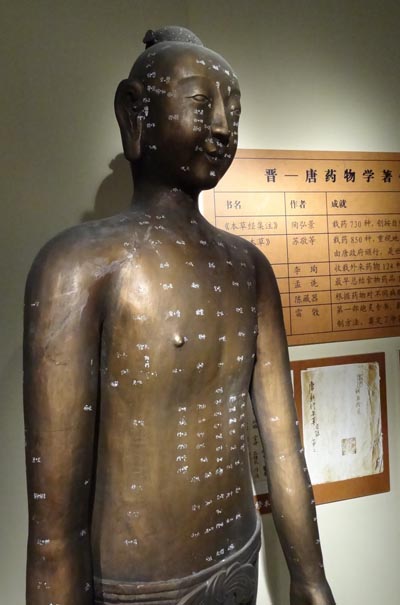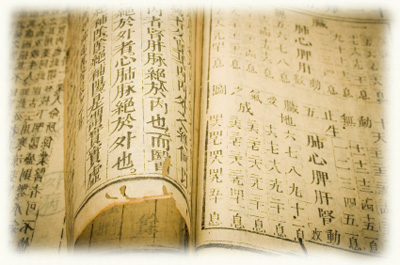Taoist & Confucian ideals
The foundations of Imperial Chinese medicine were laid in the Ancient Chinese era. Imperial Chinese medicine consolidated the concept of the "life force", Qi, with imbalances of the opposing forces, yin and yang, being responsible for disease. However, the influence of Confucius and of Taoist (Buddhist) philosophy also played a large part.
Dissemination of ideas by printing

During the Song and Yuan periods (960AD - 1368AD), printing technology advanced so that large quantities of Chinese medical texts were printed, published and translated into many languages, resulting in widespread dissemination of the principles of traditional Chinese medicine. Bronze models (pictured) were created, showing the acupuncture meridians and pierced with hundreds of acupoints; during training, the model was covered in wax (to conceal the piercings) and filled with water; accurate needle insertion would cause water to leak out.
In 1151, the newly-founded Ministry of Medicine classified all traditional medications in a printed pharmacopeia which, eventually, was carried into Europe where 60 types of Chinese medicine were adopted (recorded by Marco Polo). Conversely, books on Arabic medicine were translated into Chinese, further enriching Chinese medical knowledge.
Occupation and feudalism
During the Yuan dynasty, China was controlled by the Mongols. Whilst this proved oppressive for the people, it pushed some intellectuals into medical research and many medical breakthroughs took place. Occupation, with its associated conflicts, also resulted in a dramatic rise in external injuries, dislocations and fractures but, in parallel with this, a new community of orthopaedic surgeons appeared. They used herbal medications to induce general anaesthesia and were the most advanced practitioners of the time at treating these conditions.
 The Ming and Qing dynasties (1368AD - 1911AD) marked another period of feudalism. Many “Confucian physicians” emerged, practising a special brand of medical ethics, learning outside the government system and taught by family elders or famous doctors. Arguably the greatest work on traditional herbal medicine, the Bencao Gangmu 本草纲目, (pictured, usually called "Materia Medica"), was published during this period. It was also the era in which China produced the first man-made smallpox vaccine, used across the country and eventually exported to many other nations.
The Ming and Qing dynasties (1368AD - 1911AD) marked another period of feudalism. Many “Confucian physicians” emerged, practising a special brand of medical ethics, learning outside the government system and taught by family elders or famous doctors. Arguably the greatest work on traditional herbal medicine, the Bencao Gangmu 本草纲目, (pictured, usually called "Materia Medica"), was published during this period. It was also the era in which China produced the first man-made smallpox vaccine, used across the country and eventually exported to many other nations.
Read more about the Bencao Gangmu
Takeover by Western medicine
After 1800, missionary and other Western doctors travelled to the Qing Empire (1644AD - 1911AD) and scholars started to study Western medical texts. San Yat-sen, who led the drive for political modernisation, was a Western-trained medical doctor. Communist party officials wanted to rid China of what they thought were superstitious and non-scientific methods so, during the Cultural Revolution, many practices were banned, and practitioners were imprisoned or killed.
Some techniques, especially herbal medicine, exercise such as tai chi, and eating medicinal food, are still practised but most present-day Chinese prefer to visit modern hospitals when they are sick.
← Back to Time Corridor